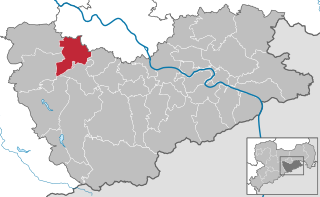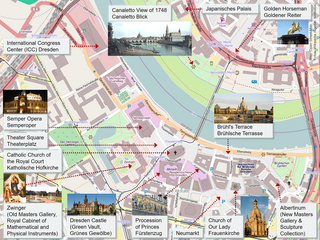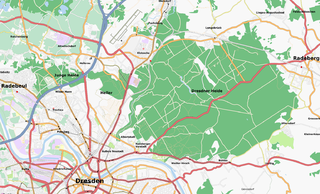
Dresden is a large city in the eastern German Free State of Saxony nearby the border to the Czech Republic at the river Elbe. The geography and urban development of Dresden is embossed by the valley location and by the Elbe stream.

Dresden is a large city in the eastern German Free State of Saxony nearby the border to the Czech Republic at the river Elbe. The geography and urban development of Dresden is embossed by the valley location and by the Elbe stream.

Dresden lies on both banks of the river Elbe, mostly in the Dresden Basin, with the further reaches of the eastern Ore Mountains to the south, the steep slope of the Lusatian granitic crust to the north and the Elbe Sandstone Mountains to the east at an elevation of about 113 metres.
The northern parts of Dresden are in the West Lusatian Highlands (Westlausiter Berg- und Hügelland). The depth influx valleys and the higher areas in the south of Dresden characterise the change to the eastern foothills of the Ore Mountains. The Elbe valley basin is a part of the Saxon Elbe Landscape. The highest point of Dresden is the Triebenberg, at about 384 metres above sea level. With a pleasant location and a mild climate on the Elbe, as well as Mediterranean architecture, Dresden was given the sobriquet "Elbflorenz" ("Florence of the Elbe").
The incorporation of neighbouring rural communities over the past 60 years has made Dresden the fourth largest urban area in Germany after Berlin, Hamburg, and Cologne.
The most important river in Dresden is the Elbe river, the only navigable body of water to flow through the city. There are also a number of tributaries such as the river Weißeritz.

The nearest German cities are Chemnitz (80 km to the southwest), Leipzig (100 km to the northwest) and Berlin (200 km to the north). The Czech capital Prague is about 150 km to the south; the Polish city of Wrocław is about 200 km to the east. There are some medium-sized towns such as Pirna (40,000 inhabitants), Freital (40,000), Radebeul (33,000 inhabitants) and Meißen (28,000 inhabitants) in the borough of Dresden. Riesa and Freiberg are not far away.
Greater Dresden, which spreads in the neighbouring districts of Kamenz, Meißen, Riesa-Großenhain, Sächsische Schweiz, Weißeritzkreis and in small parts in the district of Bautzen, has a population of around 1,250,000 inhabitants. [1]

Due to the many rural districts it has incorporated, among other things, Dresden is one of the greenest cities in Europe, with 63% of the city being green areas and forests. The Dresden Heath (Dresdner Heide) in northern Dresden is a cohesive forest of 50 km2 in size. There are four nature reserves in Dresden. The additional Special Areas of Conservation cover an area of 18 km2. The protected gardens, parkways, parks and old graveyards host 110 natural monuments in the city. [2] The Dresden Elbe Valley is a world heritage site which is focused on the conservation of the cultural landscape in Dresden. One important part of that landscape is the Elbe meadows which cross the city, 20 kilometres long.

Most of the city is in the Elbe valley, where the microclimate differs from that on the slopes and in the highlands. Klotzsche, at 227 metres above sea level, is one of the higher districts of the city. Klotzsche hosts Dresden weather station. According to experience, the weather in Klotzsche is 1-3 °C colder than the inner city's climate. Especially in summer, there are generally high temperatures at night in the city: Temperatures of 25 °C at midnight are no exception. The average temperature in January is −0.7 °C and in July 18.1 °C. [3] Summers are hotter in Dresden and winters are colder than the German average. Dresden lies in a climate zone of cold-moderate climate crossing over to a continental climate. The inner city's average monthly temperatures are almost the same as those in cities in southwest Germany; on average 10.2 °C per year. In hot summers, Dresden is between the hot Lusatia and the milder Ore Mountains. Both regions are characterised by strong winters: temperatures of −20 °C are not impossible in Dresden. The driest months are February and March, with precipitation of 40 mm. Spring months have often been arid in the last couple of years (with less than 10 mm of precipitation). The most precipitation falls in July and August, at 60 mm per month.
| Climate data for Dresden | |||||||||||||
|---|---|---|---|---|---|---|---|---|---|---|---|---|---|
| Month | Jan | Feb | Mar | Apr | May | Jun | Jul | Aug | Sep | Oct | Nov | Dec | Year |
| Average high °C | 4 | 6 | 11 | 17 | 21 | 23 | 25 | 25 | 21 | 15 | 9 | 4 | 15 |
| Average low °C | −2 | −2 | 0 | 3 | 7 | 11 | 13 | 13 | 8 | 4 | −1 | −2 | 4 |
| Average precipitation mm | 37 | 33 | 36 | 45 | 58 | 67 | 63 | 69 | 49 | 40 | 43 | 45 | 585 |
| Average high °F | 39 | 43 | 52 | 63 | 70 | 73 | 77 | 77 | 70 | 59 | 48 | 39 | 59 |
| Average low °F | 28 | 28 | 32 | 37 | 45 | 52 | 55 | 55 | 46 | 39 | 30 | 28 | 40 |
| Average precipitation inches | 1.44 | 1.29 | 1.41 | 1.77 | 2.29 | 2.62 | 2.48 | 2.72 | 1.92 | 1.56 | 1.68 | 1.78 | 22.96 |
| Source 1: weather.com [4] | |||||||||||||
| Source 2: Deutscher Wetterdienst [5] | |||||||||||||

Due to its location on the banks of the Elbe and where some water sources from the Ore Mountains flow to, flood protection is an important aspect of the city's development. Large areas are kept free of buildings to provide a floodplain. Two additional trenches of about 50 metres in width have been built to keep the inner city free of water from the Elbe river by dissipating the water downstream through the inner city's gorge portion. Flood regulation systems like detention basins and water reservoirs are almost all outside the city area.
However many locations and areas have to be defended by walls and sheet pilings. A number of districts in Dresden become locked if the Elbe river is flooding some of its old bayous.
Dresden is a spacious city, not only due to the most recent incorporations in the 1990s. The boroughs of the city differ in their structure and appearance. Many parts of city still contain an old village core, while some quarters are almost completely preserved as rural settings. Other characteristic kinds of urban areas are the historic outskirts of the city, the former suburbs with dotted housing. In Socialist times a lot of apartment blocks were built. Not unsurprisingly, the boroughs in Dresden are a mix of all these kinds of area.
The original parts of the city are almost all in the boroughs of Altstadt (Old town) and Neustadt (New town). Growing outside the city walls, the historic outskirts were built in the 18th century. They were planned and constructed on the instruction of the Saxon monarchs, which is why the outskirts are often named after the sovereigns. From the 19th century the city only grew by incorporating other municipalities.
Dresden was divided into the five Stadtbezirke (boroughs) Mitte (centre), Ost (east), West, Süd (south) and Nord (north) between 1958 and 1991. Nevertheless, these divisions had never been adopted by the local population.
Therefore, in 1991 Dresden has been divided into ten boroughs called Ortsamtsbereiche, which host subunits of the Dresden community's political and administrative institutions. These were renamed into Stadtbezirke in 2018. [6] In addition nine former municipalities which have been incorporated between 1997 and 1999 form Ortschaften which are granted a higher degree of political self-rule. Both entities are further divided into several subdistricts, called Stadtteile and Ortsteile.



Stadtteile are indicated in small characters.
Ortsteile are indicated in small characters.
The district with the largest population is Blasewitz; the largest by area is Loschwitz. The largest Ortschaft is Schönfeld-Weißig covering an area called Schönfelder Hochland (Schönfeld Highlands). The inner city consists of the Altstadt and Neustadt districts.

Dresden is the capital city of the German state of Saxony and its second most populous city, after Leipzig. It is the 12th most populous city of Germany, the fourth largest by area, and the third most populous city in the area of former East Germany, after Berlin and Leipzig. Dresden's urban area comprises the towns of Freital, Pirna, Radebeul, Meißen (Meissen), Coswig, Radeberg and Heidenau and has around 790,000 inhabitants. The Dresden metropolitan area has approximately 1.34 million inhabitants.

Loschwitz Bridge is a cantilever truss bridge over the river Elbe in Dresden the capital of Saxony in Germany. It connects the city districts of Blasewitz and Loschwitz, two affluent residential areas, which around 1900 were amongst the most expensive in Europe. It is located close to Standseilbahn Dresden funicular railway and the world's oldest suspension railway Schwebebahn Dresden, as well as near the Dresden TV tower. The bridge is colloquially referred to as Blaues Wunder. This common name purportedly referred to the bridge's original blue colour and being seen as a technological miracle at the time; it is also understood to carry the cynical connotation referencing the German idiom ein blaues Wunder erleben meaning "to experience an unpleasant surprise", reflecting the skeptical view of contemporary commentators. There is also a bridge in Wolgast known as Blaues Wunder.

Blasewitz is a larger borough (Stadtbezirk) of Dresden, Germany in the city's eastern centre on the Elbe river. It consists of seven quarters (Stadtteile):

Loschwitz is a borough (Stadtbezirk) of Dresden, Germany, incorporated in 1921. It consists of ten quarters (Stadtteile):

The Dresden Elbe Valley is a cultural landscape and former World Heritage Site stretching along the Elbe river in Dresden, the state capital of Saxony, Germany. The valley, extending for some 20 kilometres (12 mi) and passing through the Dresden Basin, is one of two major cultural landscapes built up over the centuries along the Central European river Elbe, along with the Dessau-Wörlitz Garden Realm downstream.

Freital is a town in the district of Sächsische Schweiz-Osterzgebirge in the Free State of Saxony, Germany. The town is situated on a small river, the Weißeritz, and is eight kilometres (5 mi) southwest of Dresden.

Dresden-Neustadt station is the second largest railway station in the German city of Dresden after Dresden Hauptbahnhof and is also a stop for long-distance traffic. It is the junction for rail traffic on the northern side of the Elbe. It was built in 1901, replacing the Leipziger Bahnhof, which was opened in Leipziger Vorstadt in 1839, and the Schlesischen Bahnhof, which was opened in 1847. The station building in the district of Innere Neustadt was built in the monumental style that was typical of the time, underlining its importance as a stop for long-distance services.

The Dresden S-Bahn is a network of S-Bahn-type commuter train services in Dresden and the surrounding area. It is commissioned by Verkehrsverbund Oberelbe (VVO) from DB Regio Verkehrsbetrieb Südostsachsen and currently consists of three services operating over a 127.7 km-long (79.3 mi) network.

Dresden is a cultural centre in Germany which has influenced the development of European culture. "It is [...] outstanding as a cultural landscape, an ensemble that integrates the celebrated Baroque setting and suburban garden city into an artistic whole within the river valley, and as an example of land use, representing an exceptional development of a major Central-European city."

Dresden is a major German city and capital of Saxony. It is a road, train and air transport hub in eastern Germany. Local and commuter transport services grant accessibility in the Dresden agglomeration. The city has a dense network of tram and bus lines. Dresden has two major train stations, an international airport and an inner harbour on the Elbe river waterway. Autobahns grant access to all cardinal directions. Dresden is the junction of two class-A European routes.

Dresdner Verkehrsbetriebe AG (DVB) is the municipal transport company of the city of Dresden in Germany. It is a member of the Verkehrsverbund Oberelbe transport association that manages a common public transport structure for Dresden and its surrounding areas. The DVB operates the Dresden tram network comprising 12 tram lines, with a total line length of approximately 210 kilometres (130 mi) and a total route length of 132.7 kilometres (82.5 mi), and 28 bus lines, with a total line length of approximately 306 kilometres (190 mi). It is also responsible for two funicular railways and three ferries across the River Elbe.

The Dresden Heath is a large forest in the city of Dresden, Germany. The heath is the most important recreation area in the city and is also actively forested. Approximately 6,133 hectares of the Dresden Heath are designated as a nature preserve, making it one of the largest municipal forests in Germany by area. Though mainly agricultural areas border the forest in the east, in all other directions the Dresden Heath is bordered by districts of the city and reaches nearly to the city centre in the southwest.

The Innere Neustadt is a neighborhood in Dresden within the administrative district of Neustadt. The name is derived from "Neue Königliche Stadt", the name given to the former district of Altendresden when it was rebuilt after a fire before 1732. In contrast to the Äußere Neustadt, the Innere Neustadt was within the city fortifications and, for that reason, is also known as the historic Neustadt. Its population is 7,761 (2020).

Klotzsche is a borough (Stadtbezirk) of Dresden, Germany. It consists of four quarters (Stadtteile):
Bühlau is a quarter in the east of the Saxon capital Dresden and belongs to the statistical quarter Bühlau/Weißer Hirsch. It lies in the outside of the Elbe valley between the Dresden Heath and the Schoenfeld Upland. It was first mentioned in 1349, in 1839 it formed a country commune together with Quohren and in 1921 it became incorporated into Dresden. Today, Buehlau is part of one of the Dresden villa quarters.

The Weißig–Böhla railway is a two-track, electrified main line in the German state of Saxony. It passes through an area near Großenhain called the Großenhainer Pflege and connects the Leipzig–Dresden and Berlin–Dresden railways, running between Leckwitz junction near Weißig and Kottewitz junction near Böhla. Its official opening took place after two years of construction on 3 December 2010 and the operations of regular trains started at the timetable change on 12 December 2010.

Dresden-Friedrichstadt station is a freight yard that is, along with the two passenger stations of Dresden Hauptbahnhof and Dresden-Neustadt, a central component of the railway node of Dresden in the German state of Saxony. The station precinct, which is located in the Dresden district of Friedrichstadt, also includes a locomotive depot and a regional passenger station.

The following outline is provided as an overview of and topical guide to Dresden:

Dresden I is an electoral constituency represented in the Bundestag. It elects one member via first-past-the-post voting. Under the current constituency numbering system, it is designated as constituency 159. It is located in central Saxony, comprising the southern part of the city of Dresden.

Dresden II – Bautzen II is an electoral constituency represented in the Bundestag. It elects one member via first-past-the-post voting. Under the current constituency numbering system, it is designated as constituency 160. It is located in central Saxony, comprising the northern and western part of the city of Dresden and a small part of the Bautzen district.